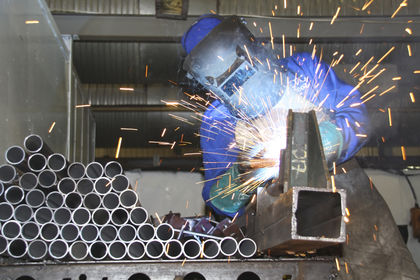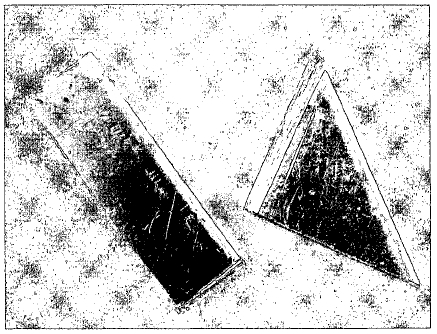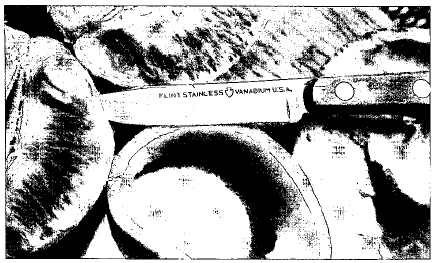VANADIUM


Overview
Vanadium is a transition metal that lies toward the middle of the periodic table. The periodic table is a chart that shows how chemical elements are related to one another. Groups 4 through 12 are the transition metals.
Vanadium was discovered in 1801 by Spanish-Mexican metallurgist Andrés Manuel del Río (1764-1849). The element was re-discovered nearly 30 years later by Swedish chemist Nils Gabriel Sefstrom (1787-1845).
By far the most important application of vanadium today is in making alloys. An alloy is made by melting and mixing two or more metals. The mixture has properties different from those of the individual metals. Vanadium steel, for example, is more resistant to wear than ordinary steel. A potentially important new use of vanadium is in the manufacture of batteries. These batteries show promise for use in electric cars.
SYMBOL
V
ATOMIC NUMBER
23
ATOMIC MASS
50.9415
FAMILY
Group 5 (VB)
Transition metal
PRONUNCIATION
vuh-NAY-dee-um
Discovery and naming
Andrés Manuel del Rio was educated in France, Germany, and England, but moved to Mexico in 1794. There he became professor of mineralogy at the School of Mines in Mexico City.
While studying minerals at the School of Mines, he believed he had found a new element. He announced this discovery in 1801 and suggested the name panchromium, meaning "all colors." The new element formed compounds of many beautiful colors. Del Rio later changed his mind and decided to call the element erythronium. The prefix erytho- means "red."
Del Río sent the mineral he was studying to colleagues in Europe for confirmation of his discovery. Unfortunately, they concluded that del Río's "new element" was chromium. Del Río's became discouraged and gave up his claim to the new element.
About thirty years later, however, del Río's element was discovered again. This time, the element was found by Sefström, who found the element in iron ore taken from a Swedish mine. He soon realized that his discovery was identical to that of del Rio's. Vanadium was eventually named for the Scandinavian goddess of love, Vanadis.
Both Sefström and del Rio saw vanadium only in the form of a compound, vanadium pentoxide (V 2 O 5 ). It is very difficult to separate pure vanadium metal from this compound. It was not until 1887 that pure vanadium metal was isolated. English chemist Sir Henry Enfield Roscoe (1833-1915) found a way to separate pure vanadium from its oxide.
Physical properties
Vanadium is a silvery-white, ductile, metallic-looking solid. Ductile means capable of being drawn into thin wires. Its melting point is about 1,900°C (3,500°F) and its boiling point is about 3,000°C (5,400°F). Its density is 6.11 grams per cubic centimeter.
Chemical properties
Vanadium is moderately reactive. It does not react with oxygen in the air at room temperatures, nor does it dissolve in water. It does not react with some acids, such as hydrochloric or cold sulfuric acid. But it does become more reactive with hot acids, such as hot sulfuric and nitric acids.
Vanadium is special in that it acts like a metal in some cases, and as a non-metal in other cases. Metals are defined as elements that have a shiny surface, are good conductors of heat

Occurrence in nature
Vanadium is a relatively abundant element, ranking about 20th among elements occurring in the Earth's crust. Its abundance has been estimated at about 100 parts per million. That makes it about as abundant as chlorine, chromium, and nickel.
Vanadium is named after the Scandinavian goddess of love, Vanadis.
Vanadium is found in a number of minerals, including vanadinite, carnotite, roscoelite, and patronite. Commercially, however, it is obtained as a by-product of the manufacture of iron. Slag and fly ash are purified to remove the vanadium metal contained within them. Slag is a mixture of materials that separates from iron and floats on top of the molten metal. Fly ash is a powdery material produced during the purification of iron.
The vanadium obtained from slag and fly ash is usually in the form of ferrovanadium. Ferrovanadium is a mixture of iron and vanadium. It can be used in place of pure vanadium in making alloys. Ferrovanadium saves companies the cost of making pure vanadium metal.
Isotopes
Two naturally occurring isotopes of vanadium exist, vanadium-50 and vanadium-51. Vanadium-51 is much more common, making up about 99.75 percent of all naturally occurring vanadium.
Isotopes are two or more forms of an element. Isotopes differ from each other according to their mass number. The number written to the right of the element's name is the mass number. The mass number represents the number of protons plus neutrons in the nucleus of an atom of the element. The number of protons determines the element, but the number of neutrons in the atom of any one element can vary. Each variation is an isotope.
Vanadium-50 is radioactive. It has a half life of about 6 quadrillion years. The half life of a radioactive element is the time it takes for half of a sample of the element to break down. Ten grams of vanadium-50 today would reduce by 5 grams after 6 quadrillion years. The other half would have broken down to form a new isotope.
Extraction
Vanadium can be obtained in a variety of ways. For example, it can be
produced by passing an electric current through molten (melted) vanadium
chloride:
It can also be made by combining calcium metal with vanadium oxide:
Uses
About 90 percent of vanadium goes into steel alloys. Steel containing vanadium is stronger, tougher, and more rust-resistant than steel without vanadium. An important application of

Compounds
The most important compound of vanadium commercially is vanadium pentoxide. Among its applications are as a catalyst for many industrial reactions, as a coloring material for glass and ceramics, and in the dyeing of textiles. A catalyst is a substance used to speed up or slow down a chemical reaction without undergoing any change itself.
An important new use for vanadium pentoxide may be in batteries. Scientists have been working for a very long time to make better batteries. Common automobile batteries are large and heavy. Batteries like these are too big and heavy for many applications. For example, they cannot be used in space probes and space vehicles. They weigh too much.
These batteries are also too large for use in electric cars. An electric car is powered by electricity rather than gasoline. A great deal of research is being done toward the development of an economical electric car.
A new vanadium pentoxide battery produces more electrical energy per pound than the lead storage batteries in cars today. They are also likely to cause fewer environmental disposal problems.
Some manufacturers think electric cars with vanadium pentoxide batteries are part of the world's transportation future. Drivers would bring these cars into a "battery filling station." The worn-out battery would be "pumped out" and replaced in a matter of minutes. Economists predict that drivers may spend as much as $6 billion per year for such batteries by 2004!
Health effects
Vanadium occurs in living organisms in very small amounts. The total amount of vanadium in the human body is estimated to be less than 1 milligram (0.000035 ounce). It is found most commonly in the kidneys, spleen, lungs, testes, and bones. No specific function for vanadium in humans has been found.
Diseases due to a lack of vanadium have been found in rats, chicks, and goats, but only under artificial conditions produced by researchers. A lack of vanadium has never been found to have any health effects on any kind of animals in natural settings.
Some manufacturers think electric cars with vanadium pentoxide batteries are part of the world's transportation future.
In large doses, vanadium can be toxic to humans and other animals. Its effects are not very serious, however. In general, the element and its compounds are not considered to be a hazard to health.
If you are just wanting to hold it